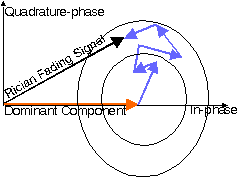
Rician fading
The model behind Rician fading is similar to that for Rayleigh fading, except that in Rician fading a strong dominant component is present. This dominant component can for instance be the line-of-sight wave. Refined Rician models also consider that
- that the dominant wave can be a phasor sum of two or more dominant signals, e.g. the line-of-sight, plus a ground reflection. This combined signal is then mostly treated as a deterministic (fully predictable) process, and that
- the dominant wave can also be subject to shadow attenuation. This is a popular assumption in the modelling of satellite channels.
Besides the dominant component, the mobile antenna receives a large number of reflected and scattered waves.

|
|
|
Phasor Diagram of Rician fading signal
|
Java Applet: Phasor diagram of one direct and 4
scattered waves (in blue),
resulting an approximately
Rice-fading envelope (in black).
|
Signal Model
|
| 
|
Hear a discussion of the basic model behind Ricain and Rayleigh fading.
|
We model a narrowband propagation channel by considering
a sinusoidal transmitted carrier
s(t) = cos wct
This signal received over a Rician multipath channel can be expressed as
v(t) = C cos wct
+ SNn=1 rn cos (wct + fn)
where
C
is the amplitude of the line-of-sight component
rn
is the amplitude of the n-th reflected wave
fn
is the phase of the n-th reflected wave
n = 1 .. N identify the reflected, scattered waves.
Rayleigh fading is recovered for
C= 0
PDF of signal amplitude
The derivation of the probability density function of amplitude is
more involved than for Rayleigh fading, and a Bessel function occurs in the mathematical expression.
It has been proposed to approximate this expression by the model for Nakagami fading, however,
the behaviour of Nakagami and Rician fading in deep fades is essentially different. Approximations that focus on the behavior near the mean value,
will divert by orders of magnitude in predicting the probability of deep fades.
Rician factor
The Rician K-factor is defined as the ratio of signal power in dominant component over the (local-mean) scattered power.
In the expression for the received signal, the power in the
line-of-sight equals C2/2.
In indoor channels with an unobstructed line-of-sight between transmit and receive antenna the K-factor is between, say, 4 and 12 dB.
Rayleigh fading is recovered for K = 0 (-infinity dB).
See also: Rician distribution, measuring the K-factor.
Rician Channels
Examples of Rician fading are found in









